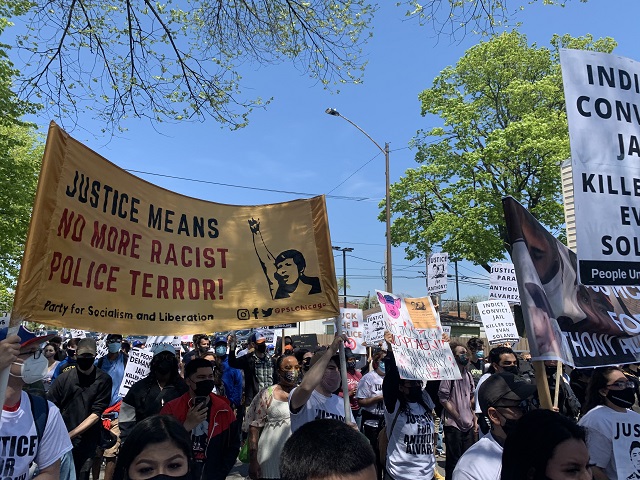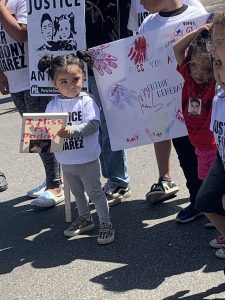Forcing the bend: On the police killing of Anthony Alvarez Comment
New in Ceasefire, Politics - Posted on Thursday, August 12, 2021 19:11 - 0 Comments

“But these grinning men were someone’s brother, son, husband, father. They were human beings, people who took immense pleasure in the utter cruelty of torturing others to death—and were so proud of doing so that they posed for photographs with their handiwork, jostling to ensure they caught the eye of the lens, so that the world would know they’d been there. Their cruelty made them feel good, it made them feel proud, it made them feel happy. And it made them feel closer to one another.” — Adam Serwer
Earlier this year, on March 31, 22-year-old Anthony Alvarez was stopped by a Chicago Police officer, Evan Solano. The reason for the stop remains unclear — body camera footage of whatever led to the stop is yet to be released. A foot pursuit followed which ended with Alvarez being fatally shot in the back five times. Two days earlier, 13-year-old Adam Toledo was shot dead after a foot pursuit by another police officer not far away in Chicago’s Little Village neighborhood.
I briefly knew Anthony. He was a student at my first school. While I did not teach him, I was aware of his reputation as a kind, caring, and inquisitive person. One interaction which remains clear in my mind was when Anthony greeted me when I returned to school after having a seizure. He told me he was so glad that I was back, and I was taken aback by this as I never had him in my class.
On Saturday May 29, I attended a protest for Anthony. While I was not close to him, I felt a duty to attend. The gathering, outside the 16th District Precinct, drew “Defend the Police” counter-protesters too. Two days later, on the two-month anniversary of Anthony’s killing, Police officers turned up on Chicago’s Laramie Avenue to tell mourners that they needed to take a memorial to Anthony down. In a video of the incident, the approaching officer begins by asking, “Where is your attorney? … does somebody speak English?” Latinx people did not speak English, was the clear implication. The crowd responded that they all did.
The video is disturbing and illustrates the degree of the disconnect between US police officers and the communities they claim to serve. The racial implications, too, are glaring. There are, for instance, plenty of memorials around Chicago for White cyclists who have been killed in accidents, yet police somehow never harass their grievers.
By the following afternoon, Anthony’s memorial had been cleared.
It is impossible not to pay attention to the timing of these events in the wider context not just of the rise of the far right during the Trump era but of the long history of police violence against racialised communities in America. As Adam Serwer points out, “the cruelty is the point”. While his article specifically refers to Trump and his supporters, it is applicable to police officers too.
Moreover, US Police violence needs a narrative of victimhood, and the “war on cops” falsehood is essential to it. Stuart Scharder explains how this operates:
Last summer, as police assaulted protesters—shoving a 75-year-old man to the ground, blinding a journalist with a foam bullet, tear-gassing a toddler—they produced a counternarrative of growing danger: Their milkshakes were being poisoned; it was no longer safe to order at the drive-thru. The threat was everywhere. Claiming to be hated for ensuring public safety reinforces the idea that critics are malcontents or sociopaths.
For the police and their defenders, maintaining this false construct is necessary to counter the idea — unfathomable for some — that the police are not only unjust, but cruel. More concretely, this police-as-victims narrative allows perpetrators of police violence to evade moral and legal culpability and accountability.
The counter-protesters on May 29, too, seemed to relish the cruelty. One of them came into our crowd, attempting to intimidate us, and nearly knocking over Anthony’s two-year-old daughter in the process. Another counter-protester appeared to be making angel wings and jumping up and down, mocking Anthony’s death. “All communists are bastards” was an overheard chant. They brandished middle fingers at us, including one motorcyclist slowly driving by, honking his horn. These ‘blue supporters’ gleefully appeared to take pleasure in our anguish.
In one interview with some of the counter-protesters, Anthony was painted as a “gangbanger” and criminal. Yet not only is there zero evidence that Anthony was ever in any gang, plenty in law enforcement are open supporters of the vigilante Kyle Rittenhouse, who shot and killed two people last August. For those who defend Kyle Rittenhouse but degrade Anthony, the cruelty, once again, is the point. The obvious truth is that the “Blue Lives Matter” movement was never about treating the police with respect, but rather a fig leaf for dehumanising Black and Brown bodies, including Anthony’s.
 To add insult to injury, the officer who killed Anthony is now being investigated not for that shooting but for a road rage incident where he pulled his gun on a (White) citizen. He has been stripped of his police powers but still has his job, and faces no legal consequences for Anthony’s killing.
To add insult to injury, the officer who killed Anthony is now being investigated not for that shooting but for a road rage incident where he pulled his gun on a (White) citizen. He has been stripped of his police powers but still has his job, and faces no legal consequences for Anthony’s killing.
That the only reason Anthony’s killer is facing any consequences at all is his on-camera aggressiveness toward White citizens is hardly novel. In the words of Ibram X Kendi, “This is the legacy of racist power” — Black and Brown bodies are viewed as intrinsically more dangerous than white ones. To the police, Anthony’s life did not matter, but those of the White citizens of Chicago do.
Having spoken with one of Anthony’s family members, it is clear they remain undeterred, as are their supporters and other local activists. In the face of hatred, contempt, and cruelty, and in the absence of real justice, we will keep standing for Anthony.
“I appreciate everyone who has been supporting us ‘til this day,” Anthony’s stepbrother, Alex Martinez, told me, “the fight isn’t over until ‘till we get justice.” For those who demand justice, we do so in the name of love, and for Anthony’s two-year-old daughter who will now grow up without a father. For her, Anthony will be a shadow without a body.
In times of frustration, it can be easy to give in. My own grandmother, a Jewish Czech Holocaust refugee, cautioned me against this danger. Until her passing in 2017, she always made it clear giving up was simply not an option. As she explained to me after Donald Trump’s victory in 2016, “What choice do we have?”
Today we manifest that same spirit in the name of Anthony Alvarez. Despite the cruelty, injustices, and feelings of futility at times, we do not give in. In his latest book, Charles M. Blow references Theodore Parker’s famous quote, popularized by Dr, Martin Luther King Jr., about the arc of the moral universe “bending toward justice”. Blow points out that this does not happen on its own, that citizens must “force the bend.”
Activists, along with the family and friends of Anthony Alvarez, will continue to pursue justice. Despite the cruelty we witnessed, from the police and from their supporters, we will keep fighting, we will keep standing up, we will keep forcing the bend.
As my own grandmother noted, we have no alternative.
[Photo credits: Mike Friedberg]



Leave a Reply